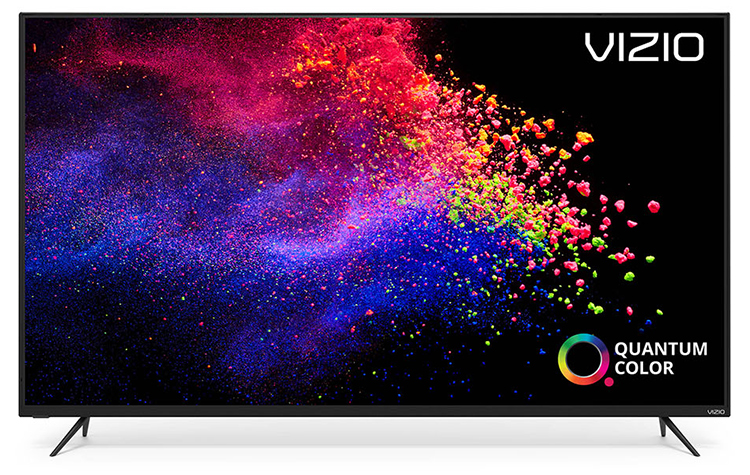
It has a full-array backlight with 90 dimming zones and covers 80% of the Rec.2020 color gamut. VIZIO continues to deliver amazing performance at equally amazing prices. The M658-G1 offers a complete solution to users looking for a new Ultra HD TV with HDR and extended color. With SmartCast 3.0, you can access content from thousands of channels, or you can hook up an Ultra HD Blu-ray player and enjoy top quality video from your favorite optical discs. It’s an impressive package for just $900.
VIZIO M658-G1 Ultra HD TV
- Ultra HD resolution with 80% coverage of Rec.2020
- 90-zone full array backlight with 600 nits peak brightness
- HDR10, Dolby Vision, and Hybrid Log Gamma support
- VIZIO SmartCast 3.0 streaming interface
- Near-perfect out-of-box color in HDR mode
- Precise color tuner with 11-point grayscale adjustment
I’ve reviewed a good number of VIZIO TVs here at Secrets and I continue to be impressed with each new model. The premium PX65-G1 I covered recently turned out to be one of the best flat panels I’ve ever tested. But if you want to save a bit of cash, the M658-G1 offers superb performance for quite a bit less. You still get a full-array backlight, but it makes do with 90 dimming zones instead of 384. And the backlight peaks at 600 nits rather than 3000. But when you watch it, you won’t instantly wish you’d bought the more expensive model. Its image quality is superb, especially in HDR mode where you won’t need to change a single setting to see an accurate picture. And you still get the excellent VIZIO SmartCast interface with its huge variety of streaming channels, Google ChromeCast, and Apple AirPlay 2 support. No matter where your content comes from, the M658-G1 will make it look its best. Let’s take a look.
Panel type:
Vertical Alignment (VA) LCD
Backlight:
65” – 90-zone full-array Blue LED Quantum Dot with local dimming
Resolution:
3840 x 2160 pixels
Effective Refresh Rate:
120Hz
Color depth:
10-bits (1.07 billion colors)
High Dynamic Range:
Dolby Vision, HDR10, Hybrid Log Gamma
Screen size:
65”
Aspect ratio:
16:9 (1.78:1)
Input signal compatibility:
up to 3840×2160 @ 60Hz
Audio:
10 watts x 2 speakers, simulated surround mode
Video inputs:
4 HDMI 2.0a w/HDCP 2.2, 1 HDMI 1.4, 1 composite
Audio:
1 optical out (DTS & Dolby Digital 5.1, PCM), 1 stereo RCA out, 1 stereo RCA in
Data inputs:
1 USB, 1 RJ-45, built-in Wi-Fi (802.11ac dual-band)
Power consumption:
192 watts
Dimensions w/stand:
57.3″W x 35.7″H x 11.8″D
Weight:
54.2 pounds
MSRP:
$900
Warranty:
One year
Company:
SECRETS Tags:
vizio, m658-g1, m-series, ultra hd tv, flat panel, hdr, dolby vision, TV Review 2019

VIZIO starts with a high-contrast VA (Vertical Alignment) panel. In the case of my sample, screen size is 65 inches with a super-thin bezel that’s barely visible when powered on. That thinness extends to the side profile which is less than three inches. The M658-G1 will look right at home mounted on the wall in any room. If you prefer to stand it on a bench, solid feet are provided and extend nearly a foot deep. The panel is very stable once set up.

The backlight delivers 600 nits of peak brightness in HDR mode and around 400 nits in SDR. If you’re wondering how different that looks from the PX65-G1’s 3000 nits, the answer is not as much as you might think. Though the PX definitely looks better, you aren’t giving up that much quality by going with the M658. Much of that is due to the huge color gamut which by my measurement, covers 79.56% of the Rec.2020 color gamut and over 109% of DCI-P3. To say that this TV has a richly saturated color would be flirting with understatement.
Contrast is also at the premium end. The VA panel starts with a high native ratio that I measured at around 6000:1. Once you engage local dimming, that number becomes unmeasurable. And though the M658 has just 90 zones, VIZIO has managed to mitigate the halo effect to where it’s almost never visible. I watched several clips with brightly lit objects on a completely black background and saw no signs of additional glow.
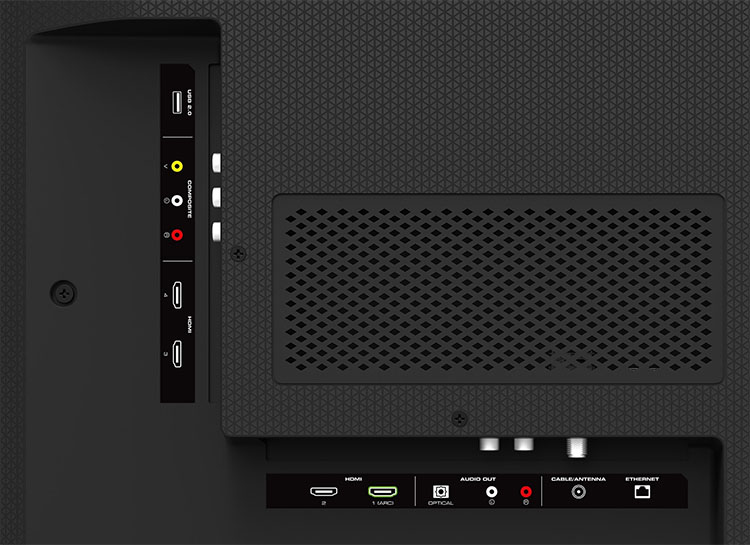
Connectivity leaves nothing out with four HDMI inputs in the back. All are version 2.0a and support HDCP 2.2. One input also includes ARC (Audio Return Channel) to send the audio stream back to a receiver or soundbar. That includes support for lossless formats up to Dolby Atmos. Legacy components can use the composite input with accompanying RCA stereo jacks. You can listen to the internal 10-watt speakers, but they won’t do most movies justice as they are focused on the upper mid-range. They will play loudly without distortion though. If you need additional audio connections, there’s an optical port that supports Dolby Digital and DTS along with a stereo RCA output. Networking happens through the set’s 802.11ac Wi-Fi or an RJ-45 jack. A threaded connector accepts an antenna signal for the internal tuner.

The remote is a minimalist affair with basic controls for menu navigation, channel, and volume. At the top are dedicated buttons for streaming services like Netflix and Amazon. There’s no backlight but the buttons are shaped differently and easy to operate in the dark. You can also control the TV with voice commands through Google Assistant and Amazon Alexa, and through the VIZIO SmartCast app using a phone or tablet. An impending update will add support for Apple HomeKit.
It is possible now to simply plug a television into the wall and watch content from the thousands of channels available over the internet. VIZIO makes this easy with its SmartCast 3.0 streaming interface. You can also cast from a multitude of devices using Google ChromeCast and Apple AirPlay 2. Cord-cutters will certainly delight in this level of ease and convenience.
The M658-G1’s physical setup was a breeze. I connected my sources, first a signal generator then an OPPO UDP-203 Ultra HD Blu-ray player, to the HDMI 1 input. I enabled full UHD color in the menu which allows access to the TVs full bit-rate and color gamut. Switching between SDR and HDR is automatic and though the picture mode label does not change, it is a separate memory denoted by either HDR10 or Dolby Vision icons. This allows independent calibration for SDR and both HDR formats using the same picture mode which is super-handy and should be the standard operating procedure for all Ultra HD displays and projectors.
Initial powerup runs the user through a series of questions regarding the set’s intended use (do not choose Store Demo), location, channel search (if you have an antenna), and network connection. The M658 instantly found my Wi-Fi access point and proceeded to download a firmware update which took just a few minutes. I was then presented with the SmartCast interface where one can spend countless hours surfing through vast oceans of content. I stuck to the basics though with Netflix and Amazon. A press of the Input button on the remote lets you change to any active HDMI port.
Calibration was a simple affair though it took a bit more work to tweak the SDR mode than it did on the PX65-G1. Out-of-box color is excellent though and, in my opinion, calibration isn’t strictly required. When I switched to HDR mode, I found there was no need for adjustment whatsoever. Its grayscale, luminance curve, and color tracking are all spot-on. For most users, the M658-G1 is a plug-and-play display.
If you choose to calibrate the SDR mode, you’ll find the same color tuner that comes with the PX65-G1. It packs a two-point grayscale adjustment and a color management system into a single small window that appears at the bottom of the screen. It’s super-easy to use and I love having everything in one place. A second screen offers an 11-point grayscale editor that I used to tweak a few individual brightness steps. The end result was a reference level image with no visible errors. The same controls are available for HDR but in my case, they were not needed. When finished, I renamed the picture mode which was then added to the list of available presets. It’s nice to leave the factory modes untouched if one ever needs to return to the default settings.

I recently obtained a copy of the new Spears & Munsil Ultra HD Benchmark which contains some incredible demo clips shot at 8K resolution. They are available in a variety of peak white levels in HDR10 and Dolby Vision formats. Watching them demonstrates the clear superiority of Dolby Vision at maximizing dynamic range and making the most of a display’s wide color gamut. The M658-G1 made it easy to discern which was which.
I ran the local dimming on its most aggressive setting for both signal types which delivered deep blacks and bright highlights without crushing any fine detail. The presentation from this disc is simply stunning.
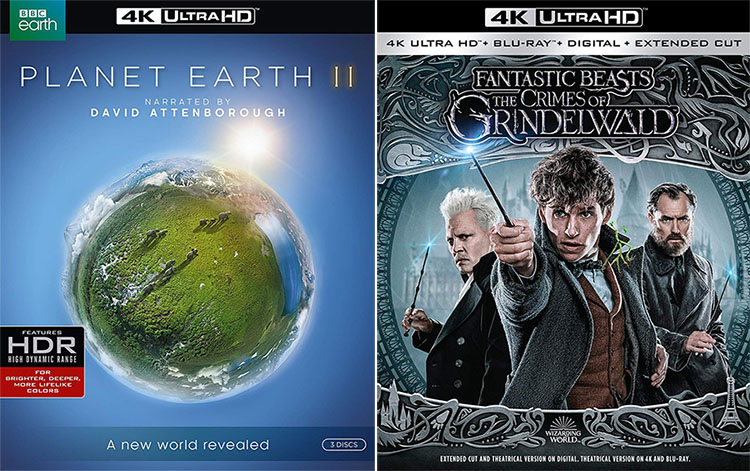
I continued with Planet Earth II which is another reference-level disc mastered in HDR10. It makes terrific use of color with especially vibrant reds and greens. The M658-G1 could strut its huge gamut here and only the PX65-G1 can compete with the image I saw. The detail is mesmerizing, especially during closeup shots where animals’ hair, dirt, and plant textures are more than just visually impressive, they are tactile. You truly feel as though you could reach out and touch them. And the deep red of molten lava falling into the sea was an impressive sight for sure.
Fantastic Beasts, The Crimes of Grindelwald is another Dolby Vision showcase that made the VIZIO look OLED-like in its black levels. Small shadow areas are truly deep in tone but fully detailed. I never saw the floating head effect or any sign that elements were missing. Again, the saturated reds and greens brought a depth to the image that just isn’t possible on even the best Rec.709 displays. The M658-G1’s color is truly exemplary.
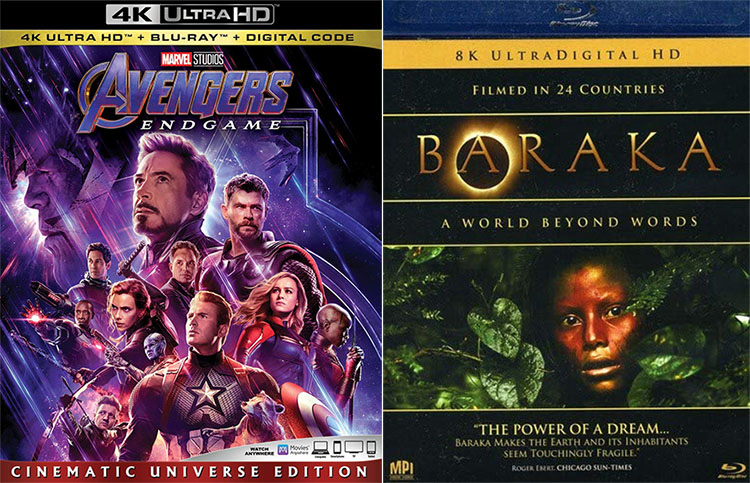
Avengers Endgame looked fantastic but compared to the Dolby Vision content I’d just watched, it couldn’t quite boast the same three-dimensional look. It still beats SDR handily though, especially in its color saturation. Most of the film is drab except when Tony Stark and Steve Rogers travel back to the 1970s. There, the warm tones really helped set a nostalgic mood that was entirely believable. In the final battle sequence, there are many instances of light glancing off metallic surfaces that make things pop nicely. This is where a higher-output display like the PX65-G1 will have an advantage.
I completed my viewing sessions with Baraka which is a reference-quality Blu-ray derived from a 70mm film original. Its color is truly breathtaking. Though one won’t mistake it for a Rec.2020-mastered transfer, the M658-G1 showed that there is still plenty to enjoy when watching good old HD and Rec.709 color. This TV will do your Blu-ray library proud with perfect scaling that is completely free of artifacts.

The M658-G1 uses the same version of SmartCast as the PX65-G1. It’s a snappy interface that’s easy to use. Finding content is convenient thanks to the cross-platform search feature. Just type the title in the box and SmartCast will tell you what services it’s available on and the fees, all on a single screen. You can also use your favorite apps like Netflix and Amazon right from the dedicated buttons on the remote.
Watching a few clips showed excellent video processing which easily competed with my benchmark streamer, the latest Apple TV. Compression artifacts were few and far between though that will depend on your internet connection. I manage around 75mbps over Wi-Fi at my house. With Google ChromeCast and Apple AirPlay 2, you can send content from your phone or tablet straight to the M658-G1. You’ll have to set up access on the TV at the start but once done, it works instantly. If you’re planning to have a cable-free experience with your Ultra HD TV, the M658-G1 makes that a convenient reality.
To test the VIZIO M658-G1’s color accuracy, I used an X-Rite i1 Pro spectrophotometer placed directly in contact with the screen. Luminance readings were taken with a SpectraCal C6 tri-stimulus colorimeter also in contact with the screen. Patterns were generated by an Accupel DVG-5000 and controlled with CalMAN, version 5.9. All tests and calibration were performed with local dimming turned off.
I started my tests in the M658-G1’s Calibrated mode. There is also a Calibrated Dark preset which differs only in its lower backlight level. For fine adjustments, VIZIO includes its Color Tuner which has a complete color management system along with two and 11-point grayscale controls. Once you’ve created your settings, you can save them under a new name that is then added to the list of factory presets.
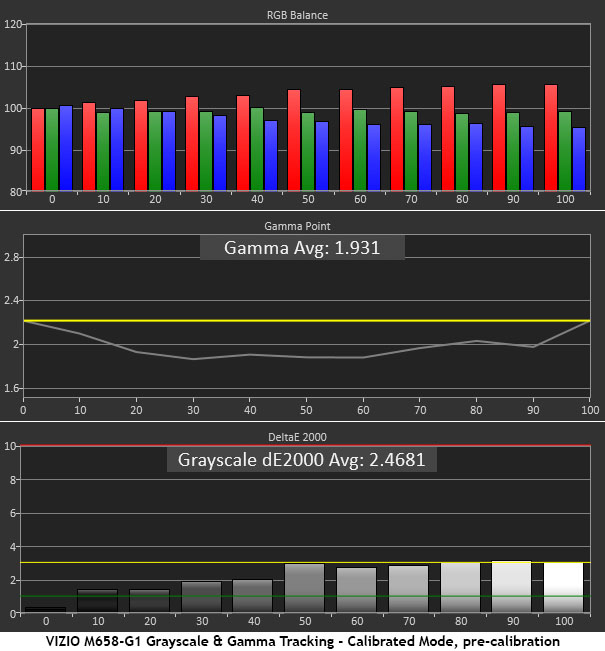
The M658-G1 comes with its gamma set fairly light and a slightly warm color temp. The grayscale error averages just 2.47dE so calibration isn’t strictly necessary. I would recommend that users at minimum up the gamma preset from 2.1 to 2.4 though. That will add depth in the mid-tones and increase perceived color saturation. Considering this is a $900 TV, I consider this excellent performance.
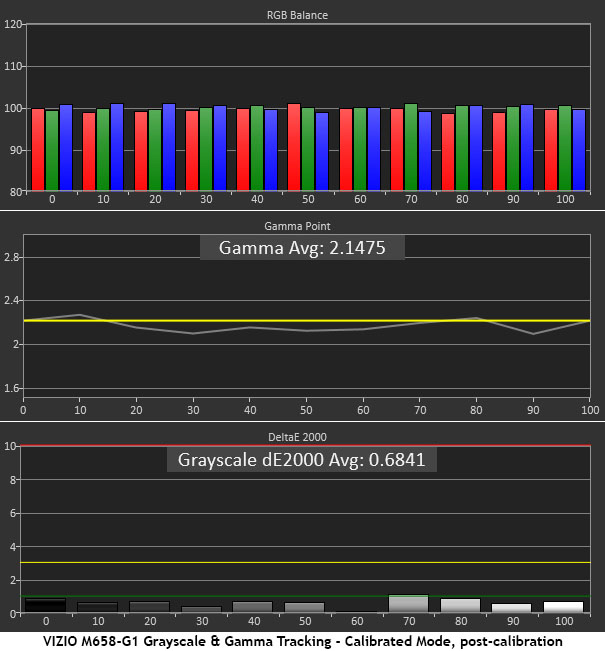
I calibrated grayscale using both the two- and 11-point adjustments. Coupled with the change in gamma, the white point average error is now just 0.68dE, reference-level. Gamma is also tighter with all values close to the 2.2 line.
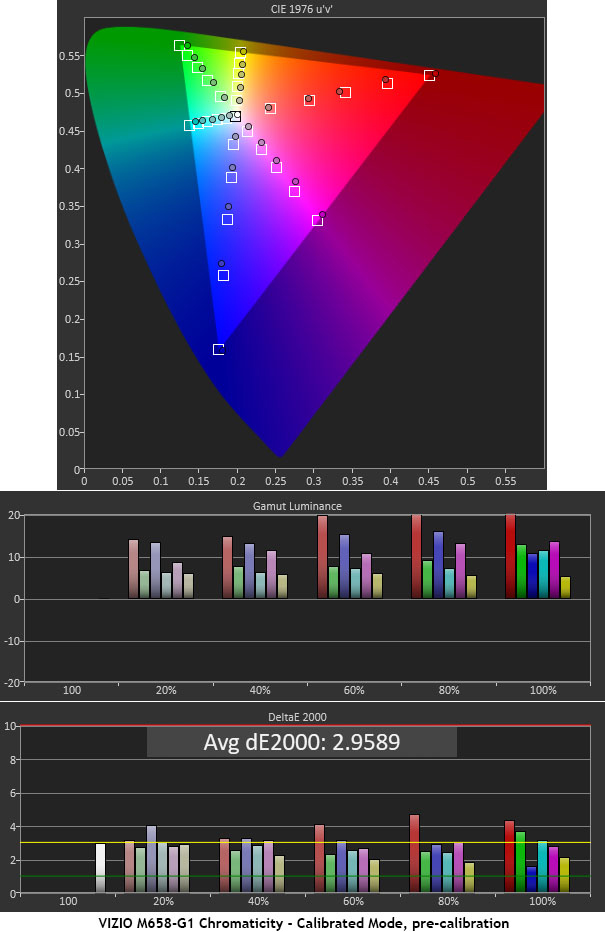
Pre-calibration color is nearly spot-on with only slight undersaturation in blue, cyan, and green. A small hue error also appears in the magenta secondary. Gamut luminance favors red which makes the picture look warm with flesh tones a bit ruddier than they should be. Green also carries a hint of yellow.
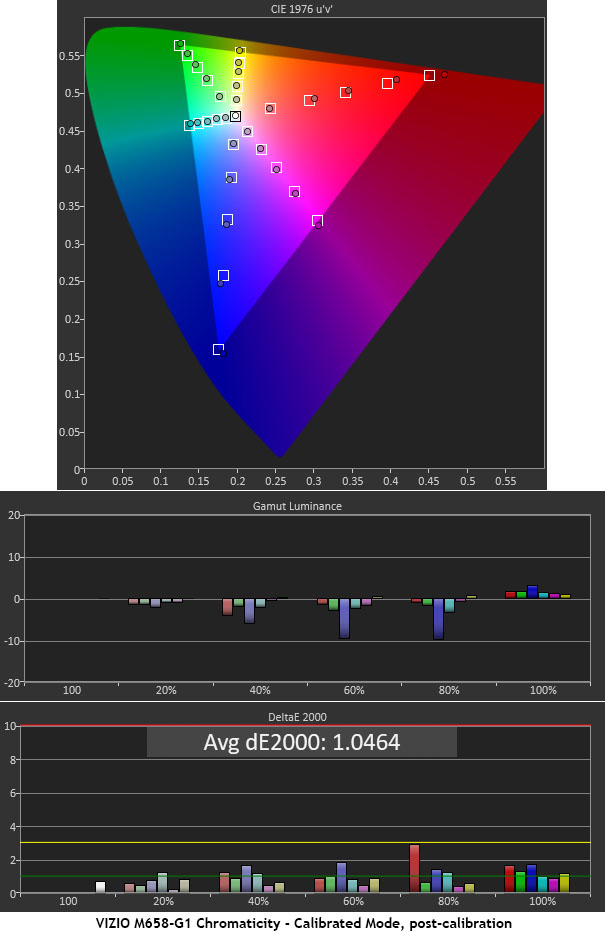
In addition to the grayscale and gamma adjustments, I tweaked the color brightness controls in the CMS. The average error is now 1.05dE which is incredibly low. I’ve provided all my settings below if you’d like to try them with your M658-G1. Red is still a touch over-saturated but by lowering its luminance, the error becomes invisible. All brightness measurements are with 10% of the neutral point and resulting errors are all less than 3dE which is the generally accepted threshold of visibility. It doesn’t get better than this folks; amazing in a $900 TV!
To simulate an HDR10 signal, I added an HD Fury Integral to the signal path. It creates the proper tone map to allow HDR measurements using CalMAN’s special workflow. These tests and the HDR calibration were performed in the M658-G1’s Calibrated HDR10 picture mode.
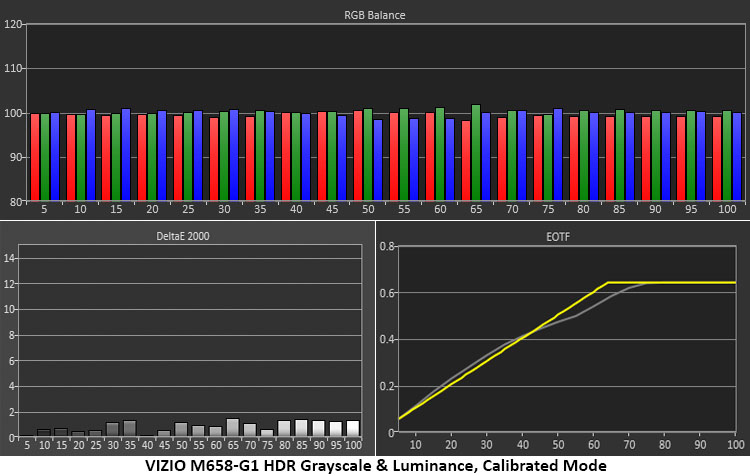
Normally, I would show a before and after chart to see the results of my HDR calibration. But given the result above, there’s obviously no need for any adjustments. Grayscale tracks with no visible errors anywhere. The luminance curve runs a tad low as it transitions to the clip point at around 63%. There are no image controls to change this but honestly, the error is completely invisible. Again, I must remind myself that this is a $900 display.
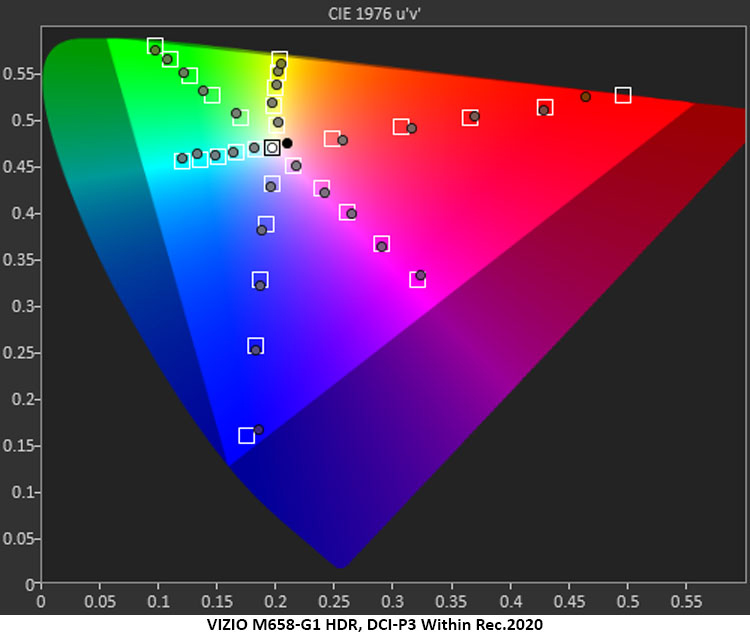
VIZIO touts the large color gamut of the M658-G1 and in that metric, it excels. It fully covers the DCI-P3 gamut though it just misses the 100% red target. This is surprising because, in the Rec.2020 chart shown below, its full-saturation red measurement is closer to the triangle’s perimeter. It’s not an issue though because most Ultra HD content is mastered to the full Rec.2020 gamut. What’s more important is how closely the display tracks the inner targets. The M658-G1 does this very accurately.
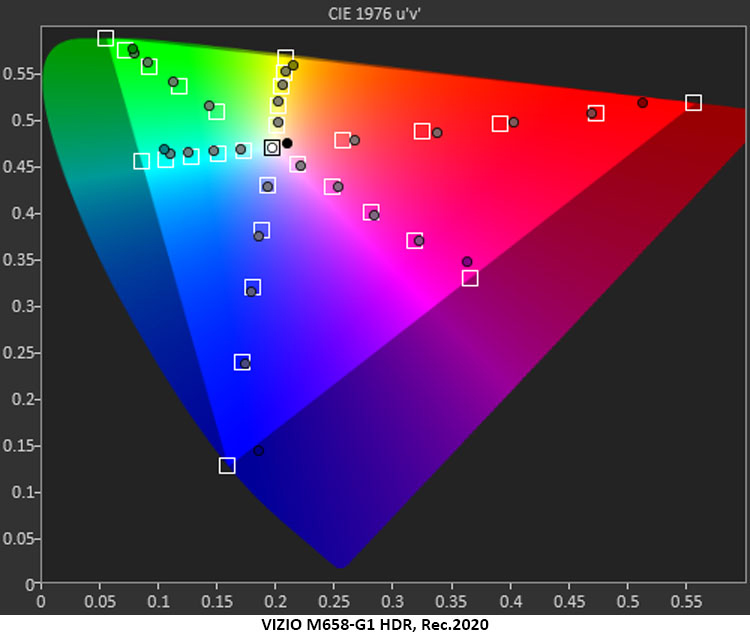
VIZIO’s claim of 80% Rec.2020 coverage is right on the mark. I calculated 79.56% which is indeed impressive. And like the DCI chart, all inner targets are where they should be. It is not enough that a display fills the gamut volume, all saturation measurements need to hit the mark for the best possible image quality. VIZIO’s engineers have certainly earned their pay here. In my experience, the only other display performing at this level is the PX65-G1.

Like it’s more expensive brother, the PX65-G1, the M658-G1 employs an eight-core chip to handle video processing duties. It passes all the de-interlacing tests including the tough 2:2 pulldown. To clean up the ship clip, I turned down the sharpness control to 10 which removed line-twitter and visible anti-aliasing. Signal resolution is best with the RGB format but 4:4:4 and 4:2:2 also render the one-pixel burst, just not as brightly.
All luminance values are expressed here in nits, also known as candelas per square meter (cd/m2). For those needing a frame of reference, 1fL equals 3.43 nits, or 1 nit equals .29fL.
In SDR mode, after calibration with local dimming turned off, I set a white level of 173.4931 (around 50fL). That resulted in a black threshold of 0.0319 and a contrast ratio of 5441.9:1. This is the panel’s native contrast which places it at the high end of LCD displays. Turning the local dimming to its lowest setting resulted in an immeasurable black level. Even placing a small info bug on the screen will not light up the center zone so there is no accurate way to measure the set’s dynamic contrast.
For max output in SDR mode, I measured 402.7241 nits white with 0.0634 nit black and a 6355.4:1 contrast ratio. Again, I had to turn local dimming off to detect any black level response.
In HDR mode with the local dimming on medium, I measured 602.411 nits peak using a 10% window pattern. The black level was 0.0075 nit and the contrast ratio was 80,321.5:1.
Here are the settings I used for my tests. SDR required a moderate amount of adjustment using all the tools available in the color tuner along with a change to the gamma preset. HDR mode was left unchanged as it measured incredibly well.
SDR
- Mode Calibrated
- Backlight 48
- Brightness 50
- Contrast 50
- Color 50
- Tint 0
- Sharpness 10
- Color Temp Normal
- Gamma 2.4
Color Tuner
| R | G | B | C | M | Y | |
| H | 0 | 0 | 0 | 0 | 0 | 0 |
| S | 0 | 0 | 0 | 0 | 0 | 0 |
| B | 0 | -1 | -1 | -1 | 2 | 1 |
| O | 0 | 0 | 0 | |||
| G | -9 | 1 | -9 |
11-point Grayscale
| R | G | B | |
| 10% | -1 | 3 | -2 |
| 60% | -2 | -5 | 4 |
| 90% | 5 | -2 | 2 |
| 100% | -2 | -3 | 4 |
HDR
- Mode Calibrated
- No other settings were changed for either HDR10 or Dolby Vision signals
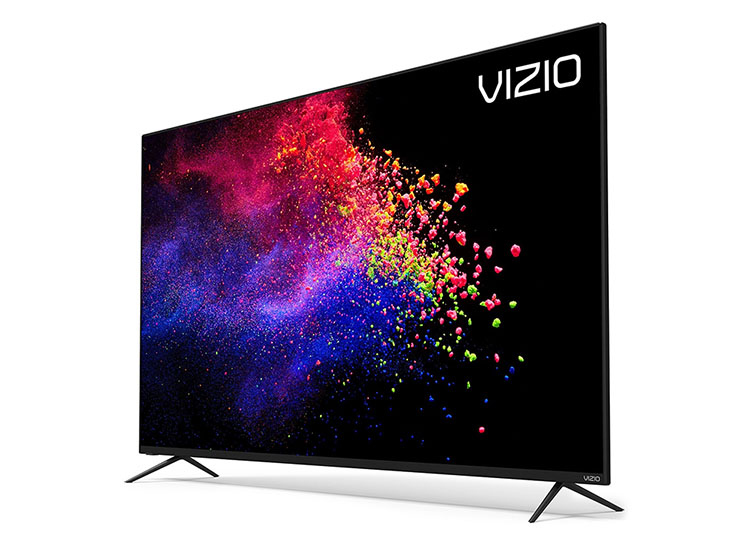
The VIZIO M658-G1 delivers fantastic SDR & HDR image quality and video performance for just $900. It’s hard to imagine getting better bang-for-the-buck than this.
- Superb image quality with excellent contrast and richly-saturated color
- Accurate color in SDR and HDR modes
- Plenty of video tweaking options
- SmartCast 3.0 streaming interface makes watching content a breeze
- No flaws of consequence
So, let’s look at the list: HDR10 and Dolby Vision, check; 600-nit backlight, check; full-array backlight with 90 dimming zones, check; 80% coverage of the Rec.2020 color gamut, check. It seems that the VIZIO M658-G1 checks the most important boxes. It has everything needed for premium quality video whether it comes from streamed sources or optical discs. If you read my review of the PX65-G1 and are asking, “Why buy the more expensive TV?” The answer is simple. Both screens will deliver a superb image. But if you want the ultimate in quality, the PX is worth the extra money. However, I can’t imagine many users not being satisfied with the M658. When you provide it with well-mastered content, it satisfies and engages the viewer. It’s bright enough for any living room and it delivers one of the best Ultra HD pictures I’ve seen.
It comes down to budget then. If you can afford to pay a little more for an Ultra HD TV, the PX65-G1 is an easy choice. If you’re inclined to save a few bucks, the M658-G1 is an equally easy choice. It doesn’t give much away to the more expensive set and for all but the pickiest videophiles, it will show a picture that rivals the best displays from competing manufacturers. At this low price point, the VIZIO M658-G1 receives my highest recommendation.


